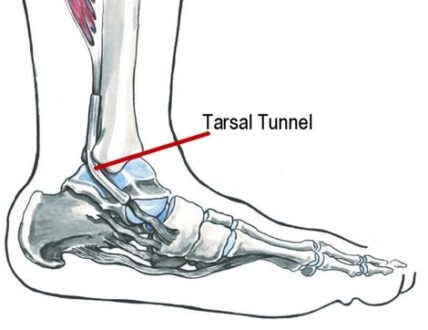Read about Tarsal Tunnel Syndrome Symptoms, MRI Test, Surgery. Tarsal tunnel syndrome plantar fasciitis.
Tarsal tunnel syndrome (TTS), also known as posterior tibial neuralgia, is a compression neuropathy and painful foot condition in which the tibial nerve is compressed as it travels through the tarsal tunnel. The tarsal tunnel is a narrow space that lies on the inside of the ankle next to the ankle bones.
The tunnel is covered with a thick ligament (the flexor retinaculum) that protects and maintains the structures contained within the tunnel including arteries, veins, tendons, and nerves. One of these structures is the posterior Tibial nerve, which is the focus of tarsal tunnel syndrome.
Tarsal tunnel syndrome is similar to carpal tunnel syndrome, which occurs in the wrist. Both disorders arise from the compression of a nerve in a confined space.

Tarsal Tunnel Syndrome Symptoms, MRI Test, Surgery
Let’s review Tarsal Tunnel Syndrome Symptoms, MRI Test, Surgery.
Tarsal Tunnel Syndrome Causes
Tarsal tunnel syndrome can be caused by any condition that causes compression of the Tibial nerve or its branches as it passes through the tarsal tunnel. A wide variety of conditions can cause tarsal tunnel syndrome including
- Space occupying lesions or masses, which may increases pressure in the tunnel. Such lesions include tumors consisting mainly of fat tissue (lipomas), tumors consisting of nerve fibers and ganglion cells (gangliomas) and tumors of the nerve sheath (schwannomas).
- Additional conditions that can cause tarsal tunnel syndrome include a benign bony growth in the tarsal tunnel (exostosis), enlarged (varicose) veins and inflammation of the synovial membrane (proliferative Synovitis).
- Certain injuries or trauma such as an ankle sprain, fracture or valgus foot deformity may cause inflammation and swelling that can lead to tarsal tunnel syndrome.
- In addition, certain disorders such as diabetes and arthritis can also cause inflammation and swelling that can lead to tarsal tunnel syndrome.
- Individuals who have severely flat feet (pes planus) are at a greater risk of developing tarsal tunnel syndrome than the general population because the flattened “fallen” arches can stretch the Tibial nerve.
Tarsal Tunnel Syndrome Sign and Symptoms
Tarsal Tunnel Syndrome Sign
- Examination may reveal Tinel’s sign (It is a tingling electric shock sensation that occurs when you tap over an affected nerve. The sensation usually travels into the foot but can also travel up the inner leg as well) over the Tibial nerve at the ankle. Manual compression for 30 seconds may also reproduce symptoms.
- Examination may reveal wasting of the intrinsic muscles in the medial aspect of the foot and sensory impairment over the sole.
- Two-point discrimination sensory testing may indicate which branch of the plantar nerve is compressed.
Tarsal Tunnel Syndrome Symptoms
- Examination may reveal Tinel’s sign (It is a tingling electric shock sensation that occurs when you tap over an affected nerve. The sensation usually travels into the foot but can also travel up the inner leg as well) over the Tibial nerve at the ankle. Manual compression for 30 seconds may also reproduce symptoms.
- Examination may reveal wasting of the intrinsic muscles in the medial aspect of the foot and sensory impairment over the sole.
- Two-point discrimination sensory testing may indicate which branch of the plantar nerve is compressed.
Tarsal Tunnel Syndrome MRI Test
MRI is ideally suited for evaluation of the tarsal tunnel due to its excellent soft tissue contrast, ability to demonstrate neurovascular and musculotendinous structures and sensitivity to soft tissue pathology.
Magnetic Resonance Imaging shows the flexor retinaculum and the structures passing deep to the retinaculum: the Tibialis posterior tendon, flexor digitorum longus tendon, flexor hallucis longus tendon, and the posterior tibial neurovascular bundle.
MRI clearly depicts the bones, soft-tissue contents, and boundaries of the tarsal tunnel as well as the different pathologic conditions responsible for tarsal tunnel syndrome.
MRI can also aid in determining whether treatment should be conservative e.g. if tarsal tunnel syndrome is due to inflammatory conditions like tenosynovitis etc. or surgical if it will be due to space-occupying lesions.
Tarsal Tunnel Syndrome Treatment
A variety of treatment options, often used in combination, are available to treat tarsal tunnel syndrome. These include:
Rest:Staying off the foot prevents further injury and encourages healing.
Ice:Apply an ice pack to the affected area, placing a thin towel between the ice and the skin. Use ice for 20 minutes and then wait at least 40 minutes before icing again.
Oral medications: Nonsteroidal anti-inflammatory drugs (NSAIDs), such as ibuprofen, help reduce the pain and inflammation.
Immobilization: Restricting movement of the foot by wearing a cast is sometimes necessary to enable the nerve and surrounding tissue to heal.
Physical therapy:Ultrasound therapy, exercises, taping and other physical therapy modalities may be prescribed to reduce symptoms.
Injection: Injections of a local anesthetic provide pain relief, and an injected corticosteroid may be useful in treating the inflammation.
Orthotic devices:Custom shoe inserts may be prescribed to help maintain the arch and limit excessive motion that can cause compression of the nerve.
Bracing:Patients with flatfoot or those with severe symptoms and nerve damage may be fitted with a brace to reduce the amount of pressure on the foot.
Tarsal Tunnel Syndrome Surgery
When non-operative treatment fails to relieve symptoms, surgical release of the tarsal tunnel may be recommended. This surgery requires an incisionbehind the ankle extending down to the arch of the foot. The ligament over the tibial nerve in the region of the tarsal tunnel is released.
The nerve is followed in the foot, and the tunnels for the medial and lateral plantar nerves also are released. The calcaneal branch frequently has its own tunnel, which also is released.Surgical release improves or resolves symptoms of tarsal tunnel syndrome in 85% to 90% of cases.
 Health & Care Information
Health & Care Information


